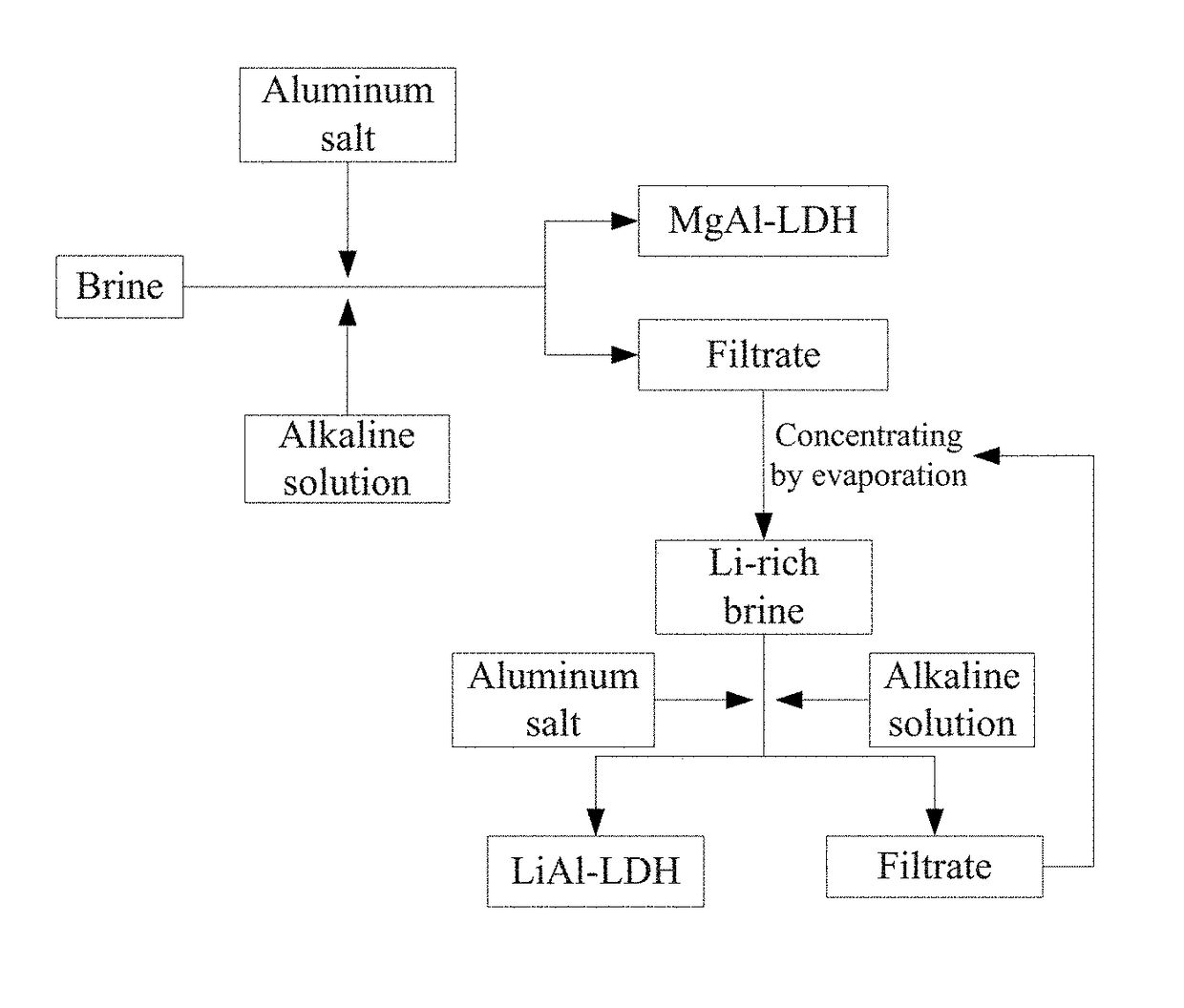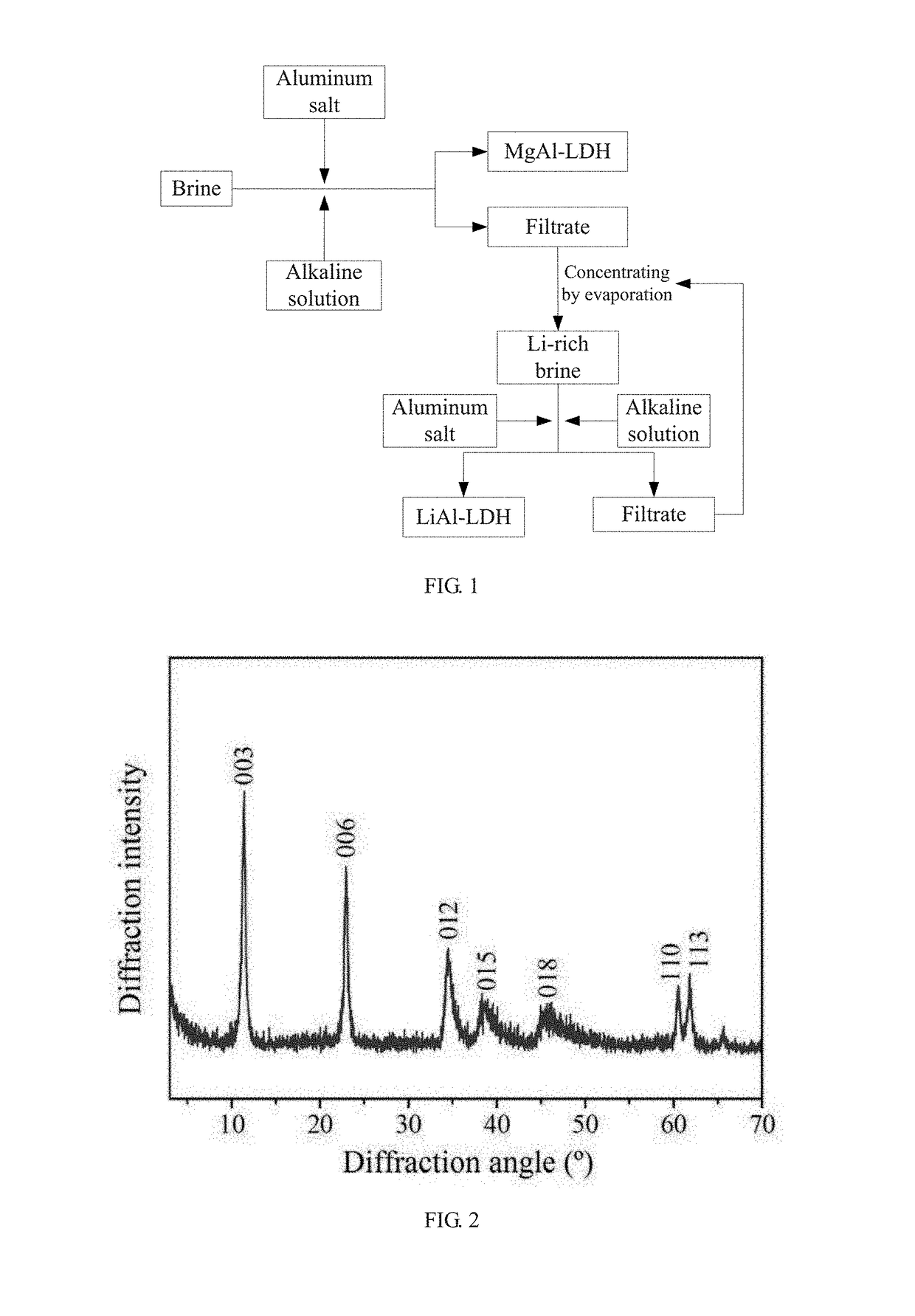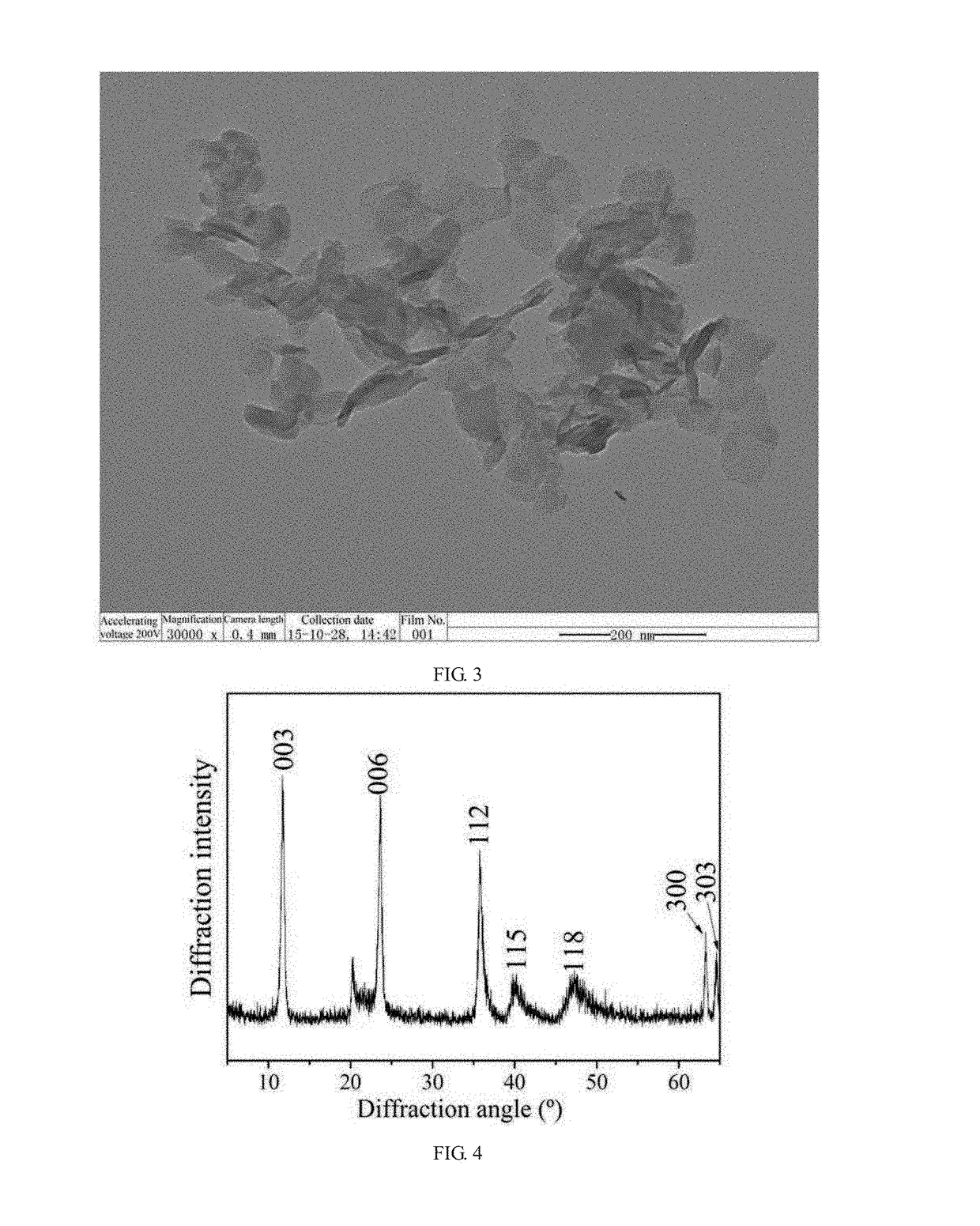Method for extracting magnesium and lithium and producing layered double hydroxide from brine
a technology of magnesium and lithium, which is applied in the field of extraction of magnesium and lithium and also producing layered double hydroxides, can solve the problems of difficult separation and extraction of lithium therefrom, current adsorbent preparation, and enormous difficulty in lithium extraction, and achieves the effects of small loss of lithium, simple equipment, and mild reaction
- Summary
- Abstract
- Description
- Claims
- Application Information
AI Technical Summary
Benefits of technology
Problems solved by technology
Method used
Image
Examples
example 1
[0068]This Example provides a method for extracting Mg and Li from brine and also producing LDH, comprising the steps of:[0069]a) 26.0325 g MgCl2.6H2O, 25.7993 g MgSO4.7H2O, 18.7290 g AlCl3.6H2O, 3.3873 g KCl, 1.8768 g LiCl, and 8.068 g NaCl were weighed out and dissolved in deionized water, and the volume thereof was metered in a 250 ml volumetric flask to obtain a mixed salt solution A; 19.8593 g NaOH and 16.4443 g NaCO3 were weighed out and dissolved in deionized water, and the volume thereof was metered in a 250 ml volumetric flask to obtain an alkaline solution;
[0070]the mixed salt solution A and the alkaline solution were added together to a colloid mill, and spun at 3000 rpm for 3 min to form crystal nuclei of MgAl-LDH; the crystal nuclei liquid was transferred to a reactor to carry out crystallization under dynamic stirring at 80° C. for 12 hours to grow MgAL-LDH; a filter cake of MgAl-LDH was obtained by filtration, and was dried at 70° C. for 12 hours to obtain a white sol...
example 2
[0075]a) 39.0487 g MgCl2.6H2O, 38.6989 g MgSO4.7H2O, 32.7187 g Al(NO3)3.9H2O, 9.1837 g KCl, 1.8768 g LiCl, and 8.068 g NaCl were weighed out and dissolved in deionized water, and the volume thereof was metered in a 250 ml volumetric flask to obtain a mixed salt solution A; 22.3368 g NaOH and 16.4443 g NaCO3 were weighed out and dissolved in deionized water, and the volume thereof was metered in a 250 ml volumetric flask to obtain an alkaline solution;
[0076]the mixed salt solution A and the alkaline solution were added together to a colloid mill, and spun at 4000 rpm for 5 min to form crystal nuclei of MgAl-LDH; the crystal nuclei liquid was transferred to a reactor to carry out crystallization under dynamic stirring at 80° C. for 12 hours to grow MgAL-LDH; a filter cake of MgAl-LDH was obtained by filtration, and was dried at 80° C. for 6 hours to obtain a white solid product of MgAl-LDH, and the filtrate was collected in a container; the formula of the MgAl-LDH is [Mg0.8Al0.2(OH)2]...
example 3
[0079]a) 39.0487 g MgCl2.6H2O, 29.139 g MgSO4.7H2O, 71.2620 g Al2(SO4)3.18H2O, 9.1837 g KCl, 1.8768 g LiCl, and 8.068 g NaCl were weighed out and dissolved in deionized water, and the volume thereof was metered in a 250 ml volumetric flask to obtain a mixed salt solution A; 22.3223 g NaOH and 16.4443 g NaCO3 were weighed out and dissolved in deionized water, and the volume thereof was metered in a 250 ml volumetric flask to obtain an alkaline solution;
[0080]the mixed salt solution A and the alkaline solution were added together to a colloid mill, and spun at 2000 rpm for 6 min to form crystal nuclei of MgAl-LDH; the crystal nuclei liquid was transferred to a reactor to carry out crystallization under dynamic stirring at 70° C. for 10 hours to grow MgAL-LDH; a filter cake of MgAl-LDH was obtained by filtration, and was dried at 80° C. for 8 hours to obtain a white solid product of MgAl-LDH, and the filtrate was collected in a container; the formula of the MgAl-LDH is [Mg0.744Al0.256(...
PUM
| Property | Measurement | Unit |
|---|---|---|
| concentrations | aaaaa | aaaaa |
| molar ratio | aaaaa | aaaaa |
| molar ratio | aaaaa | aaaaa |
Abstract
Description
Claims
Application Information
 Login to View More
Login to View More - R&D
- Intellectual Property
- Life Sciences
- Materials
- Tech Scout
- Unparalleled Data Quality
- Higher Quality Content
- 60% Fewer Hallucinations
Browse by: Latest US Patents, China's latest patents, Technical Efficacy Thesaurus, Application Domain, Technology Topic, Popular Technical Reports.
© 2025 PatSnap. All rights reserved.Legal|Privacy policy|Modern Slavery Act Transparency Statement|Sitemap|About US| Contact US: help@patsnap.com



